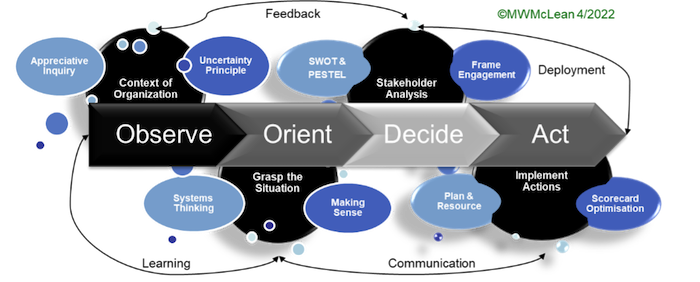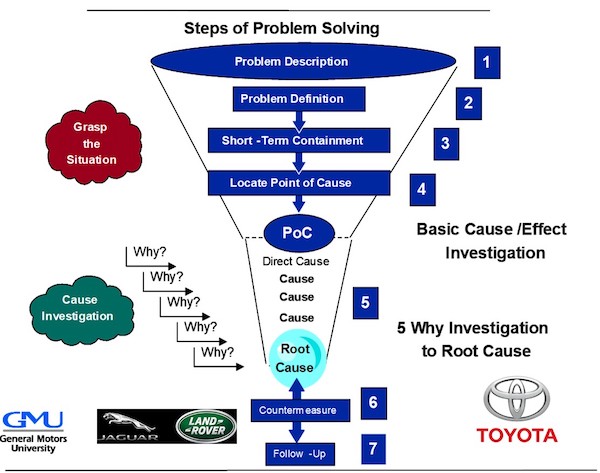The Management Consulting Profession Use of Sensemaking to Solve Clients’ Problems
Michael W McLean CMC-AF, FACID, FAOQ, Juran Medallist. Australia
Management consulting can be summarised as an advisory service. It is usually contracted to conduct industry research or provide independent organisation or market analysis for business cases and executable actions. Others are engaged in exploring both risks and opportunities to improve organisational challenges and solve problems top management face on their business plan horizons.
It may also be supporting a management team to identify and assist them in taking full advantage of growth opportunities and assist in implementing changes whilst identifying possible risks and constraints to oversee implementation. In some ways, these interventions are the basis for this paper. How does a single consultant, or perhaps one collaborating within a team locally or maybe nationally or even internationally, gather enough evidence to define and scope an assignment? ISO 20700:2017 Guidelines do help here.i
Every new or experienced management consultant will face different contexts, environments, and situations that they must consider. A consultant may need to steer through their professional practice or just experience, select appropriate strategic, tactical, and operational methodologies to help in their analysis, and then design an optional solution. There are many these days to draw upon. We all have a ‘lens’ to assess, e.g., strategy, business analysis, scorecards, stakeholders, engagement, growth, structure, planning, systems, OD, excellence, improvement, talent, supply, technology, security, and transformation for one or more interventions (Kraaijenbrink, J. 2015ii). Table 1 lists some methodologies which consultancies may use.
Table 1: Some external and internal analysis tools for consultants (M. W. McLean, 2022)
| A partial list of External and Internal Factors and Interventions | ||
|
| |
Completing such analyses and others can be emotionally challenging but fun. Yet the insights gained are fundamental to understanding what is relevant and of value for a consultant to bring to an engagement. It is also essential to grasp what additional skills a consultant will have to draw upon, acquire or seek collaborations (ISO 44001iii) to help the client, and grow as a professional consultant.
The key to a successful engagement is knowing yourself and your capabilities and being frank about what you can bring to a tender, proposal, submission and, if won, to a client’s assignment.
The following approaches are drawn from an ‘old’ management consultant who had engineering, productivity, quality, and HR management roles before joining a management consultancy. WDScott trained me across several internal consulting, business improvement, productivity analysis and management, process action teams, and statistical analysis methodologies.
WDScott was Australia’s first management consultancy. It merged to form Coopers & Lybrand WDScott, which became PricewaterhouseCoopers. I started my practice, McLean Management Consultant Pty Ltd, in 1988 and merged with Bywater, then Axon PLC UK. Including my brief history provides a window into what one can draw upon to make sense of an assignment (Weick,1995iv). Some techniques and authors will be mentioned; the list is not exhaustive. As all professional management consultants have a degree or higher, it is expected that such studies embed a yearning to learn and build upon continually.
The OODA Loop
OODA Loop (Boyd, 1976v) is a valuable technique for consultants. The OODA loop is Observe – Orient – Decide – Act, like Heisenberg’s Uncertainty Principlevi. Let us assume you have been engaged and bring in-house systems, methodologies, and techniques from your consultancy to an assignment. Now the fun begins through its application:
- Begin to Observe the business, its operations, the management team, the interactions, the fundamental interactions of customers and suppliers and others to understand the client’s context
- Then Orient yourself and your consulting team to the range of possible interventions that could address what you observed
- Then Decide based upon the evidence collected, data analysed and information provided or interpreted to define the problem/s objectively, and
- Act to refine and agree on the assignment scope (once again, use ISO 207001 templates).

You may find it or the following as further adaptations of OODA Loop and Appreciative Inquiryvii (AI).
| Figure 2 shows the OODA Loop for the IMC, where the “Orient” was expanded to suggest possible interventions. “ICT” is Information Communications and Technologies | Figure 3. Another variation by the Australian Army – The Adaptation Cycleviii of sense-decide-adapt-act. |
 |  |
SWOT and PESTEL Analyses
SWOT Analysis for Internal Factors for assessing, ranking and actions in an assignment. The matrices are likely different from what you may have seen and used and are drawn from consulting projects.
Table 2: SWOT analysis template
| Client Internal Factor SWOT Analysis | Ranked ‘W’ & ‘T’ Factors | Agreed Actions | |
|
Strengths ___ ___ ___ |
Weaknesses ___ ___ ___ |
Evidence-Based Weaknesses 1. 2. 3. |
Description and Who 1. 2. 3. |
|
Opportunities ___ ___ ___ |
Threats ___ ___ ___ |
Evidence-Based Threats 1. 2. 3. |
Description and Who 1. 2. 3. |
Table 3: PESTEL analysis template.
| Client External Factor PESTEL Analysis | Ranked PESTEL Factor | Agreed Actions | ||
|
Political ___ ___ ___ |
Economic ___ ___ ___ |
Society ___ ___ ___ |
Evidence-Based 1. 2. 3. |
Description and Who 1. 2. 3. |
|
Technologies ___ ___ ___ |
Environment ___ ___ ___ |
Legislative ___ ___ ___ |
Evidence-Based 1. 2. 3. |
Description and Who 1. 2. 3. |
Stakeholder Matrix Analysis
“The ultimate criterion is how well all stakeholder needs are being served” (Covey, 2008 ix)
Europe, America, Australia, and the Middle East now have national and regional business excellence models that guide organisations to identify their stakeholders or interested parties. In some countries like the USA, each state has developed similar models. The Shingo Prize for Operational Excellence and ISO 9004:2018 Guidance to achieve sustained success also focus on process optimisation and the satisfaction of an organisation’s stakeholders.
These stakeholders must be agreed, their needs and expectations defined (say three) to align the site, department or process goals to meet a stakeholder requirement (See EFQM Above the clouds, 2006x; Blue Ocean Strategy; Kim & Mauborgne, 2005xi).
Table 4: Stakeholder analysis template.

Problem and Root Cause Analysis
“If the only tool you have is a hammer, every problem looks like a nail” Law of the Instrument. (Maslow, 1966xii )
It is time for reflection on what you have learned from the implicit knowledge you have gained and the tacit knowledge by engaging with various people within the engagement (Nonaka, 1995 xiii). It would be easy to think that once you have some evidence for assessing your client’s environment and clarifying the strategy and current goals, you may be able to define the actual problems, challenges, or risks. A register of possible solutions to the problem is then valuable.
A popular methodology is the Toyota practical problem-solving methodology used in General Motors and Jaguar Land Rover (Liker, 2003 xiv).

There are many problem-solving methodologies to research, and one will suit the client’s context. They will have one already, and it is best to use theirs to respect their problem-solving methodology. Sensibly, upon your disengagement, they will go back to their approach, which is usually embedded and audited within their management system. Sustainment of any recommendation and improvement after you leave is part of the joy of management consulting, especially if the client sustains the results/outcomes (See Align xv Trevor and Varcoe, 2020 and Management Systems, Kaplan and Norton in The Execution Premium xvi2009).
Some of these techniques will undergo further refinement. You may find it a Wicked Problem and not easy to identify, define, and search for What really works (Joyce et al., 2003 xvii). Of course, there are other models you will learn during your career to observe and orient your interventions and solutions to suit the client’s context (Johns, 2006 xviii) and make sense of it all for them and yourself.
A consultant’s career and the joy of assignments mean you are always learning in white water Peters xix, 2001.
Michael W McLean CMC-AF, FACID, FAOQ, Juran Medallist. Australia
https://au.linkedin.com/in/michaelwmclean
References
i ISO 20700:2017. Guidelines for management consultancy services. https://www.iso.org/standard/63501.html
ii Kraaijenbrink, J. The Strategy HB. 2015. https://www.amazon.com/Strategy-Handbook-Practical-Refreshing-Making/dp/9082344300
iii ISO 44001:2017. Collaborative Business Relationships – Requirements. https://www.iso.org/standard/72798.html
iv Weick, K. Sensemaking in Organizations. 1995.https://us.sagepub.com/en-us/nam/sensemaking-in-organizations/book4988
v Olsen, JA. Boyd Revisited. 2016. https://www.jstor.org/stable/26276810?seq=1
vi The Heisenberg Theory. 2003. https://plato.stanford.edu/entries/qt-uncertainty/
vii Cooperrider, D and Whitney, D. Appreciative Inquiry. 2001. https://en.wikipedia.org/wiki/Appreciative_inquiry
viii Army – Adaptive Campaigning. 2009. https://researchcentre.army.gov.au/sites/default/files/acfloc_2012_main.pdf
ix Sanders, DJ. 2008. Built to Serve. Foreward by Stephen R Covey Page xii. https://www.abebooks.com/9780071497923/Built-Serve-Drive-Bottom-Line-0071497927/plp
x EFQM, Above the clouds, Greenleaf. 2006. https://www.booktopia.com.au/above-the-clouds-efqm/ebook/9781351280549.html
xi Kim, WC & Mauborgne, R. Blue Ocean Strategy. 2005. https://prolightinggroup.com/wp-content/uploads/2020/08/Blue-Ocean-Strategy-Expanded-Edition_-How-to-Create-Uncontested-Market-Space-and-Make-the-Competition-Irrelevant-1.pdf
xiiMaslow, AH. 1966. Psychology in Cognitive Sciences. P15. ISBN 9780976040231. https://philpapers.org/rec/MASTPO
xiii Nonaka, I, and Takeuchi, H. 1995. The Knowledge-Creating Company.
xiv Liker, J. The Toyota Way. 2003. https://www.amazon.com.au/Toyota-Way-Jeffrey-K-Liker/dp/0071392319
xv Trevor, J and Varcoe, B. 2020. Aligned organizations. https://hbr.org/2017/02/how-aligned-is-your-organization
xvi Kaplan, R and Stanton, S. The Execution Premium. 2008. https://www.amazon.com.au/Execution-Premium-Operations-Competitive-Advantage-ebook/dp/B004OEIPYQ
xvii Joyce, W, Nohira, N, Roberson, B. What (really) works. 2003. https://hbr.org/2003/07/what-really-works
xviii Johns, G. 2006. The essential impact of context on organizational behavior. Academy of Management Review, 31(2): 386-408. https://www.semanticscholar.org/paper/The-Essential-Impact-of-Context-on-Organizational-Johns/866564951d067e9156e8410a9fcadcece4555209
xix Peters, T. 2001. Talent. https://tompeters.com/wp-content/uploads/2014/02/Talent.pdf